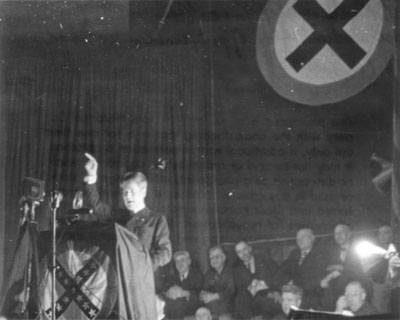“Roads Not Taken” of the Depression Era .
On April 28, 1938, five thousand people gathered in the Livestock Pavilion in Madison, Wisconsin, to hear Governor Phil La Follette announce the creation of the National Progressive Party. On the stage, behind the small and studious – looking governor, was an immense banner bearing the party’s emblem — a blue cross in a red circle. It was a shocking and unmistakable takeoff of the Nazi Party’s symbol — some called it a “circumcised swastika.” Around the pavilion stood national guardsmen in shiny steel helmets, emblazoned with the party’s jarring insignia.
The old parties were “fumbling the ball,” La Follette told the excited, roaring crowd. The good intentions of President Roosevelt were being “sabotaged, undermined and humstrunt” by dissension in the Democratic Party, and especially by its reactionaries. For liberal Americans who longed for change, the National Progressives, he proclaimed, was not a third party but rather “THE party our time.”
The party platform, however, puzzled some observers. “We are near the end of the road,” La Follette exclaimed. “The time has come when a new trail must blazed.” Exactly what kind of trail did he have in mind? The governor refused to offer “blueprints.” What kind of progressivism was he offering then? He ruled out “failed capitalism,” insisting that capitalism had become obsolete. His brand of progressivism, he said, meant no more “coddling or spoon-feeding of Americans.” The executive branch needed power “to get things done.” But he opposed military preparedness and hammered FDR’s naval buildup.
His statements were alarmingly, ominously vague. “We must have a method and be able to act collectively, but preserve at the same time individual initiaitve.” In a frightening emotional appeal that made short shrift of reason, he declared that only true believers — “those who come with complete conviction and without reservation” — were welcome in his party.
A darkly shadowed photo in Life of La Follette on the podium with his arm outstretched, as if giving the Nazi salute, captured for many the menacing drift of his party. When asked about the party insignia, La Follette gave the imrobably explanation that the gigantic X stood for the cross that citizens marked on their ballots, a symbol of their inalienable rights. Interviewed by writer Max Lerner in his office, where he displayed a photograph of Mussolini, La Follette, who had visited Germany in 1933, spoke admiringly of the Fuhrer’s “positive achievements” and energy.
La Follette’s National Progressive Party managed to inspire some Americans — and it also aroused one former president, Herbert Hoover. The new party, Hoover slyly remarked, might be just the wedge needed to divide Democrats and return Republicans to power. (*) […]
For his part, Roosevelt was seriously worried about a third party threat, though he joked about the grotesque Nazi resonances of the National Progressive Party. Writing to his friend William Phillips, the ambassador to Italy, the president described La Follette’s dedication of his new party emblem on a twenty foot wide banner. “All that remains,” he wrote, “is for some major party to adopt a new form of arm salute. I have suggested the raising of both arms above the head, following by a bow from the waist. At least this will be good for people’s figures.”
Roosevelts Purge
Susan Dunn
p 106 – 108

(*) Note that this was Hoover was thinking in 1936 with concerns to Huey Long and the eventual “National Union Party”.